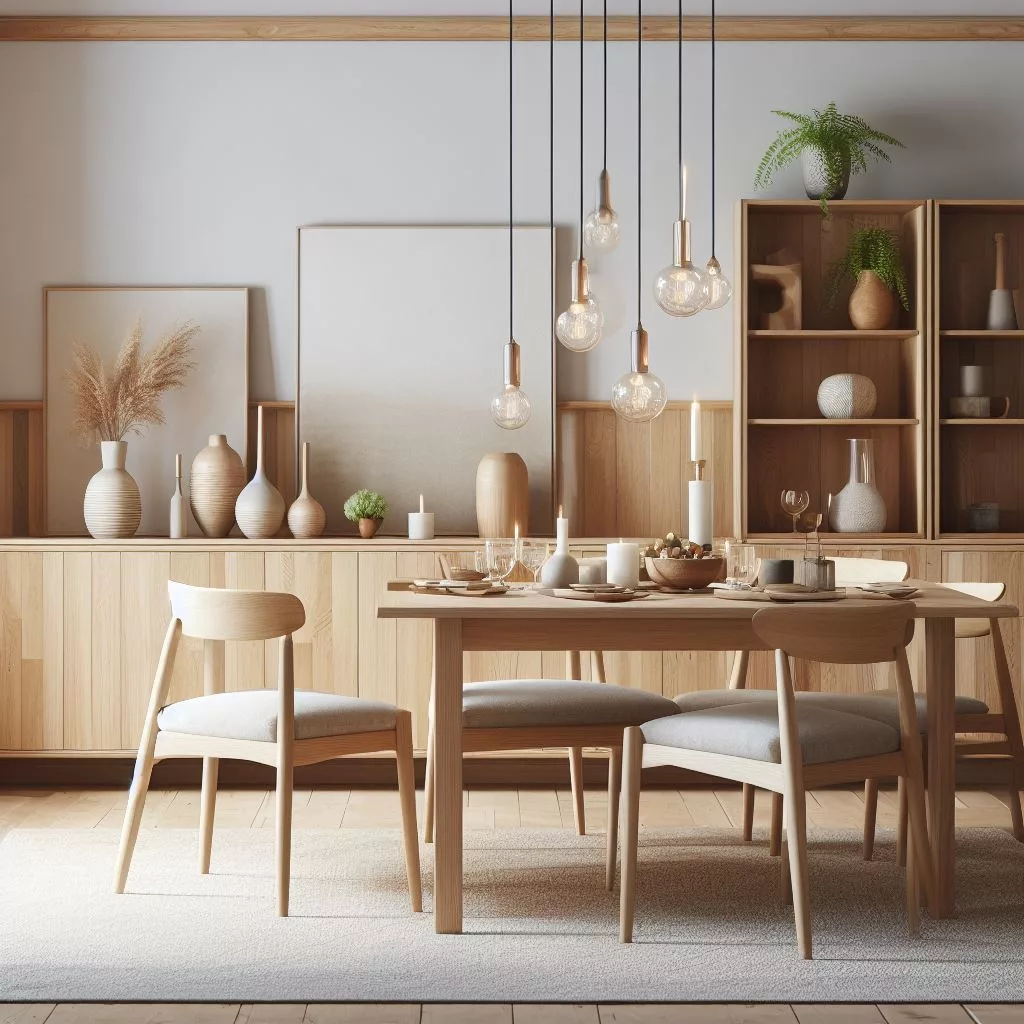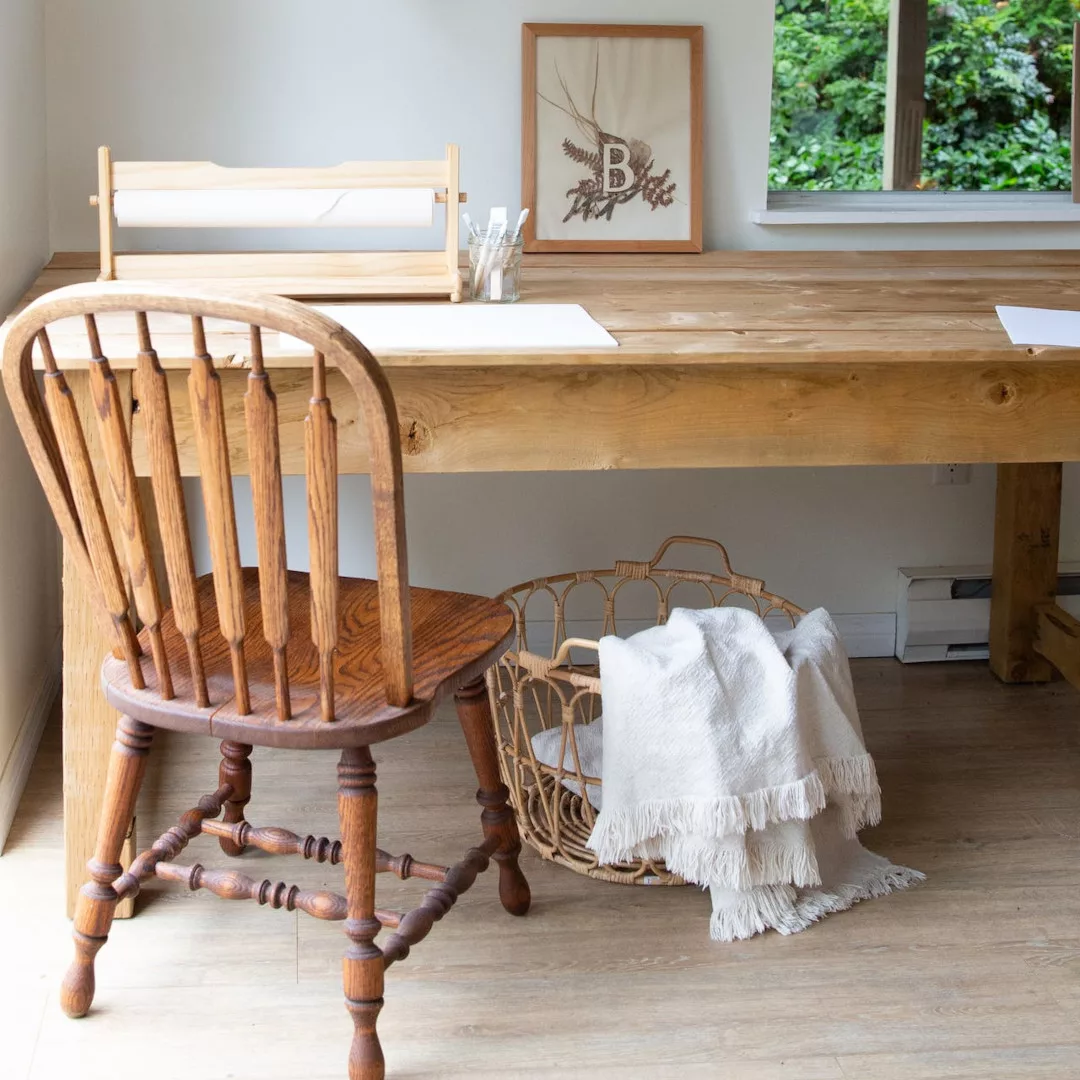
UPDATED: November 2025
You have probably noticed the trending popularity of the “natural wood look” or “raw wood finish,” where the final result is a beautiful piece of furniture that looks as if it is raw wood without a single coat of finish.
The challenge is, even an ultra-clear coating or lacquer on light woods can add a “wet” look to your project that shows the appearance of the finish on it.
So, what if you want that raw, flat, natural wood look, but you ALSO want your project to have a water, chemical and scratch resistant finish on it?
I’ve had success using Target Coatings’ Emtech® EM1000 Universal Sanding Sealer to create a base coat that helps achieve this natural wood look.
The EM1000’s ultra-clear and deep penetrating formulation helps you easily and effectively brighten your wood substrate WITHOUT creating an overabundance of haziness in the finished project.
Below are suggestions and tips to help you create this base coat and natural look finish. I’ll also provide pictures of some samples I fabricated in my shop to show side by side comparisons of different techniques.
In Part 1 of this 3-part series, I’ll share more about the challenge — and the overall process — of creating the natural wood look.
In Part 2, I’ll share the “5 Steps” and specifics and details for each step…
And in Part 3, I’ll share examples of what my final results and sample boards look like.
So, let’s dive right in…
Part 1: The Challenge and Process of Achieving a Natural Wood Look
What is the Challenge of a Natural Wood Finish?
I first encountered a request for a natural wood look a few years ago when my wood shop partner asked me if I could make the solid maple furniture bookshelf I was building look as if it was unfinished.
I’ve always loved the appearance of a very clear finish, but all finishes will darken your substrate in some way — some finishes more than others. Even an ultra clear finish darkens the wood slightly giving it a wet look.
Since I love a challenge, I really gave it some thought and decided if I could whiten the finish a little, this would brighten the wood and counteract the wet look.
At the time, I had some glossy white enamel in my shop, so I just added a small amount of this paint to Target Coatings EM1000 Universal Sanding Sealer and, after a lot of stirring and then straining through an ultra fine mesh, I had a sealer coat that would ultimately lead to creating a process in our shop that was applied on quite a few different pieces of furniture of different wood species.
In most cases, this is a final look where you’ll want to do some of your own experimentation, but I hope to provide some basic guidelines to get you started on the path to creating the formula that works for you.

What is the Process to Achieve a Natural Wood Finish?
The process is simple enough — you want to apply a small amount of white tint to your first and possibly second coats to brighten the wood. However, there’s a delicate balance to the process since you want enough white to brighten your substrate, but not so much white that you begin to see a white haze (although some people like that look as well.)
In Part 2 of this post, we will explore some possible combinations and sheens that will give you multiple options and set you on the path of creating the process that works for you.
I will be working with two popular white Tints on the market: Golden Fluid Titanium White and Mixol Oxide White #25…
We will explore grain filling or no grain filling…
And finally, we will briefly discuss the differences between a Satin, Flat and an Ultra-Flat finish.
(Speaking of Ultra-Flat, quick PSA: EMCAT+ EC2A Topcoat and Emtech EM9300 Polycarbonate Urethane are both available in a 5%, Ultra-Flat sheen.)
I’ll provide pictures of samples on what I think are the two most popular woods, White Oak and Maple, but this process can work on any lighter wood like Birch, Hickory, Ash, etc. Woods with darker grain or heartwood can be a little trickier because they will reflect the white more. I’ve included a sample of Sapele to illustrate this a little better.
There will be some people who like this look on darker woods so you’ll need to create some of your own samples and fine tune the process to achieve the results you’re looking for.
Do you have any experience or opinions on creating the natural wood look? Please share your thoughts or read what others are saying in the comments section below.
Seth Kline has been a woodworker, wood finisher and business owner for the past 25 years. After helping grow his family’s home remodeling firm — Roy B Kline & Son — both as a craftsman and business operator, in 2013 Seth became the co-owner, lead woodworker, and shop manager of Stor Handmade Furniture, a highly successful solid wood furniture shop specializing in bespoke, hand-made and hand-finished pieces. In 2023, Seth launched SBCraftsman, which offers spray finishing and small business consulting to private clients. Originally from Pennsylvania, Seth now resides in Aberdeen, N.J., and is a proud member of the Central Jersey Woodworkers Association.


I am still very much a novice in spray finishes, and only been using Target Coatings for a few months. I do enjoy experimenting though!
Could you share some of the proportions you used with the white enamel and the sanding sealer. It might give us a bit of a starting point.
Thank you and I’m looking forward to reading more.
Hi Karl,
Thank you for commenting and your interest in this technique. This was a long article and will be released in 3 parts. Please stay tuned as I provide some suggested proportions for mixing a tinted base coat, some tips and suggestions for how to apply the tinted sealer and topcoats, and even some pictures contrasting this technique with an un-tinted finishing technique.
Seth, I’ve got to admit that I’m really excited to see for myself how well this finish will come out, as I have just the project in mind for it. Thanks for sharing your wealth of finishing knowledge with us. I can hardly wait to see what other tricks you’ll be revealing in the next 2 parts. Bring ’em on!!
Cheers from Canada,
Marty Schlosser
Hey Marty, thanks for the positive feedback.
I always very much enjoyed and appreciated all the articles you posted for Target Coatings.
I look forward to adding my humble contributions to the vast wealth of knowledge found on this website in the way of tips, special techniques, and comprehensive information on finishes, that is provided to Target Coatings customers and the finishing community at large.
hi! do you use a white tint by Target Coatings?
Hi Justine,
Target Coatings does not offer a white tint for this process.
I recommend you use one of two different tints that are readily available online. One is, Titanium White from Golden Fluid Acrylics, and the other is, Oxide White #25 from Mixol. I have found both tints to be comparable to each other so for some it will come down to personal preference.
Please remember to distribute and mix the tint in a little warm water before adding it to your base coat.
Thank you for the three articles, just amazing results! Can’t wait to give this a try.
Hi Larry,
Thank you for the positive feedback. I’m so glad to hear you enjoyed the articles.
If you have any follow up questions about the process while doing your own experimenting, you can always contact us via our contact form on the website for additional help.
When showing several wood finishes I find the most preferred finish is oil and wax. Most people prefer a finish that brings up the colour and figure in the grain, along with the very smooth and touchable appeal that a very thin finish that leaves the texture of the wood apparent all add to the appeal. There are several ways I’ve found to get this. Tung oil rubbed onto a finely sanded surface (320) and then wet sanded with 400 and then another coat sanded at 600 and finally a wet coat rubbed with fine steel wool or scotch brite. Finally a coat of quality wax and buffed out. This is a fantastic looking and feeling finish but also the most fragile of the choices. French polished shellac can achieve a similar appearance but takes a bit of experience to apply and get just right. Finally a thin spray application of water based lacquer and rubbed to a sheen (but not mirror) can get a similar appearance but again takes some experience to apply at the right thickness (too much material and it starts to look artificial) and has the advantage of providing more protection. I’m looking forward to experimenting with a ceramic micro finish over all 3 of the above (I would leave out the wax and go over the cured tung oil). It looks promising in that it could give added protection over a natural look.
Hi Bob,
Thanks so much for adding to our discussion on this topic and offering some insights into alternate methods for creating a natural look finish.
-Seth Kline
I really appreciate how relevant your articles always are. It seems all of our clients want rift white oak with a raw wood look.
I have just made a large desk with a solid cherry top and finished the whole project with EM9300. This is the second time I have used the product and been really satisfied with the result. I do the spray application -HVLP – in my garage so it is not always the best situation for dust etc, although I do take as much care as possible. In this case I have managed to get a nice smooth finish straight off the gun.
Previously before switching to water based products I used 2K solvent based reaction lacquers. With the cured finish on those products I was able to – finish the finish – if needed, by sanding/rubbing with 800 to 1000+ grit wet and then using rubbing compound grades to achieve a final smooth silky finish.
To achieve the same result with EM9300 what should the process be?
Graham,
Thank you for your post and or sharing your EM9300 results with our readers.
You can use the same 800/1000 schedule but do not use any soap or detergent to lubricate the pads – only use a very small amount of mineral oil (not mineral spirits), to work the higher grit schedules.
-JeffW-